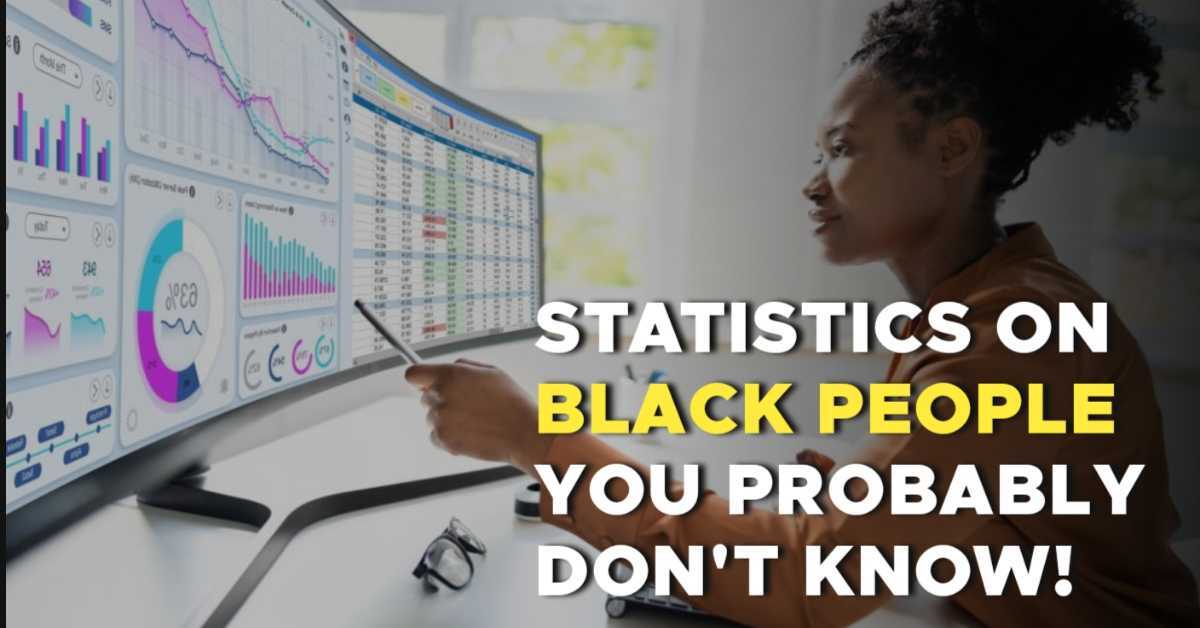Black people, also known as African Americans, have a rich history and culture in the United States and other parts of the world. Despite their contributions to society, they have faced discrimination, marginalization, and systemic racism throughout history.
Despite these obstacles, Black people have continued to thrive in various aspects of society, making significant strides in areas such as education, business, politics, and sports. However, its not all cheerful and positive. In several facets of life, they’ve had to endure silly discrimination for things like their hair colour. How unfortunate is that.
This is a complete list of up-to-date black people statistics.
On this page you’ll find hand-picked stats about:
- African Americans
- Stats about Black Asians
- Statistics on Black Africans
- Black People in Europe Stats
- Black People in the Caribbean
- Statistics on Black People in America
- Black People Killed by Police in America
- Unarmed Black People Killed by Police in America
So, without further ado, let’s see the stats!
Before that let’s look at the origins of the black community and race.
Key Black People Stats
Let’s kick things off with supercritical stats about black people, community and race. I pulled these from various studies, surveys, reports and even statements from academia. Let’s dive right in.
Who are Black People?
Black is a racist classification of individuals, and it is typically used as a political and skin color-based category for specific communities that have a complexion ranging from mid brown to dark brown.
It is not always about the skin color sometimes it could be where you are geographically located. Almost all sub-Saharan Africans are considered blacks even though there are some light skinned individuals among them. So where are they from? Who created them?
Who created Black People?
It sounds even silly to say this but hey, black people are also humans just as any other human on this planet. So, whoever or whatever caused the existence of humans also caused the existence of black people.
To say more about the “whoever” or “whatever, the cause of the existence of humans cannot be a cosmic accident as some theories seem to suggest.
A little scenario to help illustrate the point, let’s just say you are on the beach alone and you came across these words along the shore “Hey, did you bring any spices?”. Right from there you wouldn’t be thinking a lot about the cause of those writings.
You would certainly not think the waves wrote it neither would you even consider the crabs or lobsters by some chance accidentally wrote it. You would probably conclude that some mind or intelligence is behind these writings.
That’s the point, anytime we observe specified complexity (instances of information that is complex and cannot be explained by chance) we reason back to an intelligent mind. You saw just six words on the beach and you concluded an intelligent mind is behind it, how about if you found a book with billions of words carrying meaningful information?
A very ultra intelligent mind would be assumed to be the cause of such a huge chunk of complex information, right? We humans are made up of genetic material that carries tens of billions of information. And the conclusion? It just has to be an intelligent mind behind the existence of humans and just not humans, the entire universe.
How Many Black People are on Earth?
There are black people all over this earth. To get an exact number of these people is nearly impossible. According to world population review, there are roughly 1.2 billion black people on earth and that’s if you define blacks as those with sub-Saharan African descent.
What Country has the Least Amount of Black People?
St. Helena which is the least populated country in Africa also has the least number of black populations. The country has a total population around 6,126 people according to wordometer.info. out of this number only around 70 (1% of the population) are black as at 2020 (the available data). The figure below is constructed using a dataset from census.org.
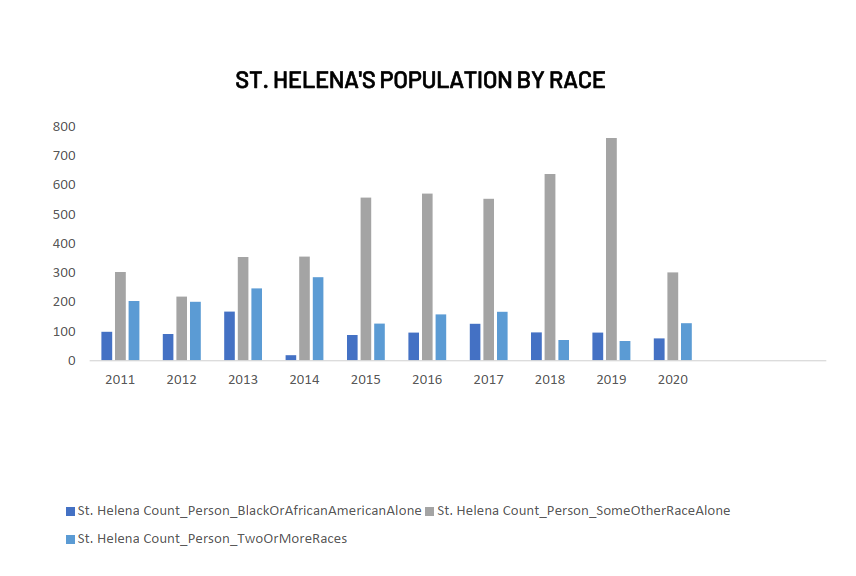
African Americans Stats
The number of African Americans are increasing. Self-identified Black individuals accounted for a projected 47.2 million persons in 2021(14% of the nation’s population). This represents a 30% increase from 36.3 million African Americans in the U.S.
Kudos to pew research center for the hard work done on the statistics of black people.
This section provides a profile of the black population in the United States in 2021, including its demographic, geographic, and economic characteristics.
How many African Americans are in the U.S?
As stated earlier, the number is around 47 million as at 2021. The African American population has increased by more than 10 million since 2000 when there were approximately 36 million blacks.

What is the median age of black people in America?
The African American population in the US is young. Black people’s median age in 2021 was 33, which was five years younger than the 38 median age of the US population. Around 30% of all Black people were under the age of 20, and 12% were 65 or older.


Which State in the U.S Has The largest black population?
From the pew research center, the highest proportion of Black people in the U.S. in 2021 is in the South; more than half (56%) live there. After the South, 17% of people live in the Midwest, 17% in the Northeast, and 10% in the West. The figure below represents this graphically.
With around 4.0 million Black residents (14% of Texas’s total population), Texas has the greatest Black population among the states. Georgia comes in third with 3.6 million, closely followed by Florida with 3.8 million.
However, the district of Columbia has the highest percentage of blacks (46.53% of D.C population) followed by Mississippi (38.83%) and then to Louisiana (33.24%)
Its importantly to note the difference between percentages and population to prevent confusion. Percentages represents proportions of something.
A little scenario here; think of two class rooms, class A and B. Class A has a total of 100 students; 40 males and 60 females. Class B has only 10 students, 8 males and 2 females.
Class B has the highest percentage of boys compared to class A but class A has a greater population of boys than class B. Is this still confusing?
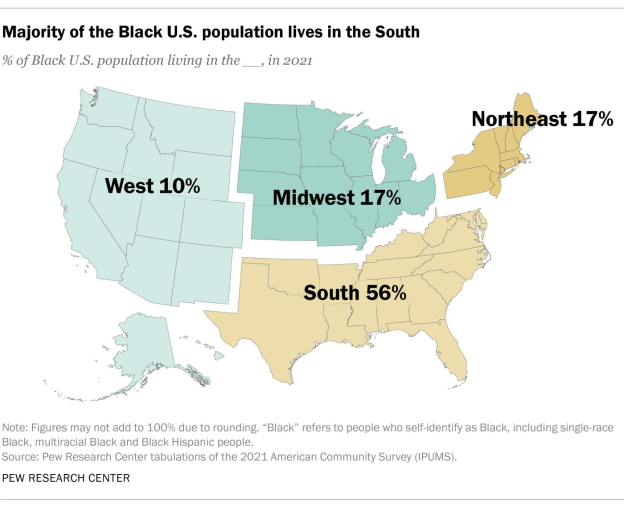
Which state has the least amount of black people?
The lowest population of Black people is found in Wyoming, where there are 11,306 (2%); it is followed by Montana (12,007 (1%); and Vermont (12,936 (2%).
How many African Americans are married?
As of 2021, 39% of African Americans in the United States reside in married-couple-headed households. Around 31% of Black people live in households where the household head is a woman, and 5% live in households where the household head is a man. Less than two out of ten people (16%) live in non-family households (Pew Research Center).

How much do black people make per year in the U.S?
The median household income for Black households in the United States in 2021 is $46,400. Broader research reveals that 48% of African American households earned $50,000 or more, compared to 52% who earn less than $50,000. 31% of Black households earn $75,000 or more annually, 20% of which earn $100,000 or more.

How many blacks have a college degree?
All African Americans aged 25 and older who have a bachelor’s degree or above make up almost a quarter (26%) of the population.
As of 2021, a third (32%) had some college experience, and about four in ten (42%) had at most completed high school or earned an equivalent such as a GED certificate (Pew Research Center).

How many blacks are religious?
All Black individuals (66%) who identify as Protestants are in the majority. The percentage of adults who identify as religiously unaffiliated is about one in five (21%); lower proportions of adults identify as Catholic (6%); other Christian denominations (3%); or non-Christian faiths (3%). See figure below.
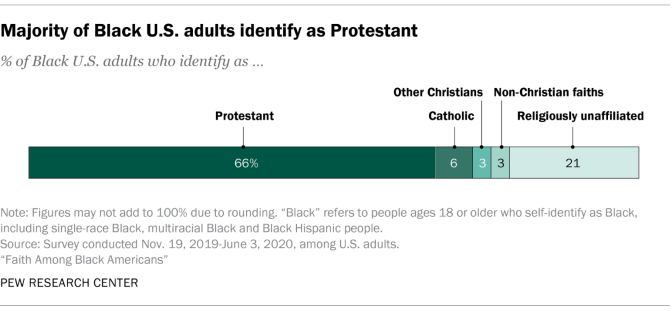
How many blacks are in prison?
Although the United States currently has the highest imprisonment rate in the world, the rate has generally been declining over the previous ten years.
In absolute numbers, there were about 465,200 black inmates in state or federal prisons at the end of 2018, a 21% decrease from 590,300 at the end of 2006. The number of white inmates fell 15% during the same period – from 507,100 to 430,500 – while Hispanic inmates increased 5%, from 313,600 to 330,200 according to the pew research center.
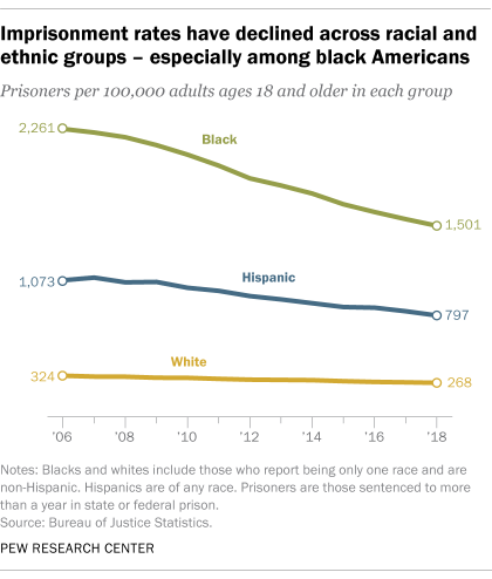
What percentage of black people are in prison?
Black Americans made up 33% of those serving time in jail in 2018, more than double their 12% share of the adult population of the United States. 30% of convicts were white, which is roughly half their 63% representation of the adult population. Compared to 16% of the adult population, Hispanics made up 23% of the prison population.
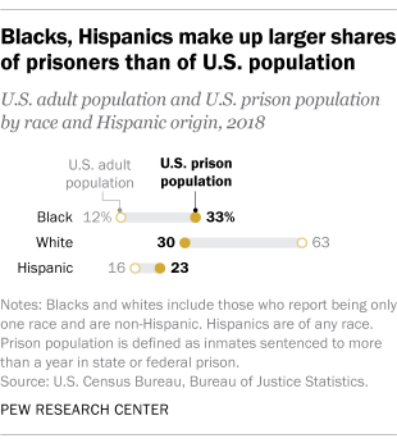
BLACK PEOPLE KILLED BY POLICE IN AMERICA
Compared to other developed countries, American police kill a disturbingly high number of individuals, according to J. Lartey (Lartey 2015).
In the US, one of the main causes of death for young males is police violence. One in 1,000 black men can anticipate being killed by police during their lifetime. In all racial and ethnic groupings, the risk of being killed by police peaks between the ages of 20 and 35 (Edwards, Leeb et al. 2018).
As comparison to white people, black people, American Indians, and Alaska Natives have a much higher risk of being killed by police. Moreover, Latino men are more likely than white guys to be killed by police (Edwards, Leeb et al. 2018)
Let’s look at some actual statistics coming from an actual dataset collected by the Washington post’s database from January 1st 2015 to 3rd January, 2023 (As this dataset is updated every day, it should be noted that the most recent date used for this analysis was 2023-03-06).
How Many People Are Killed By The U.S Police Every Year?
Overall, 8,269 killings have occurred from 1st January, 2015 to 6th March,2023 (This gets updated daily). 1,000 individuals are shot and killed by police each year in the US, according to this database by Washington post. Both those who are armed and those who are not are included in this statistic.
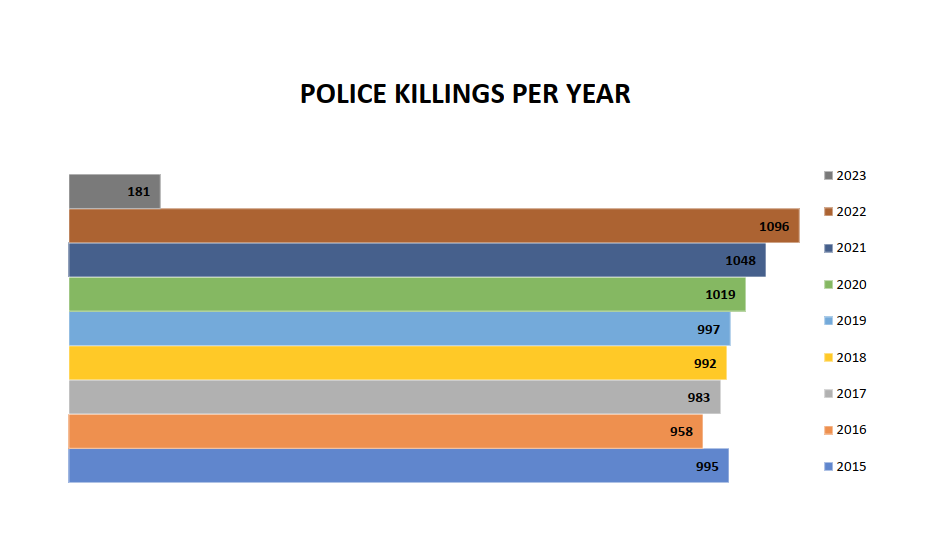
How Many Black People Were Killed By The Police?
Averagely every year, from 2015 to present, 16 Americans of Asian heritage were killed. 406 Whites, 143 Hispanics, 213 Blacks, and 12 Native Americans are killed averagely per year. Below is a chart that shows the distribution of police killings by race.
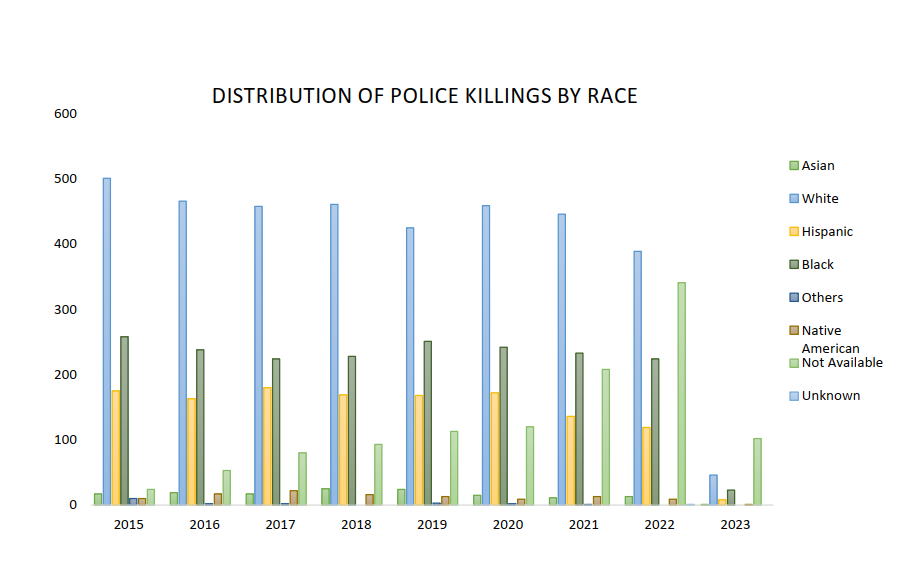
How Many Unarmed Black People Were Killed By The Police?
466 unarmed people have been killed by the police according to the Washington post dataset. Out of this number, 149 are black. In the nutshell, approximately 32% of unarmed people killed by the police are blacks.
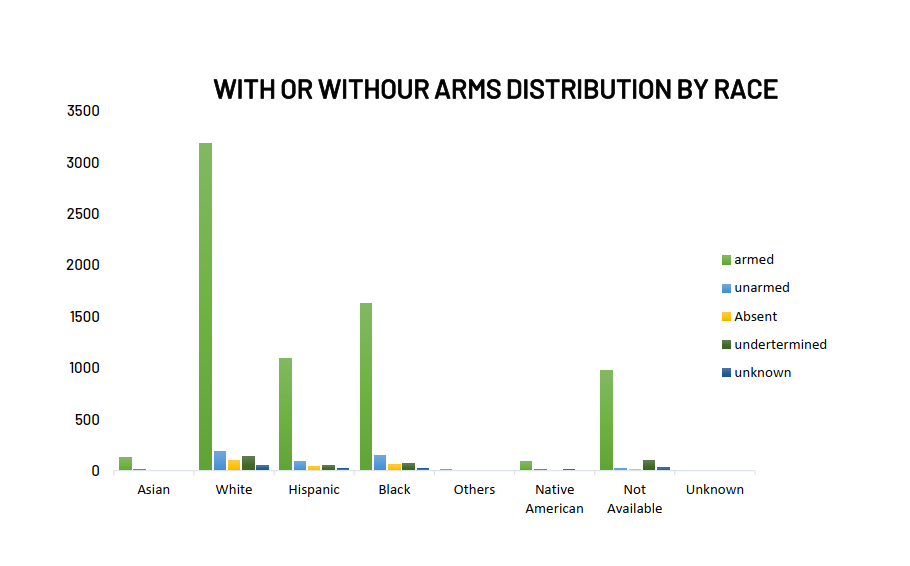
How Many Mentally Ill Black People Were Killed By The Police?
Looking at the data, over 1,900 black people have been killed from 2015 to present by the American police averaging a little bit over 200 black people deaths per year. 288 out of the 1921 (representing 15%) black victims were mentally sick. 75% of black people killed by the police (from 2015 to present) were mentally healthy.
As shown below, 27% (984 /3651) of white victims were mentally ill and the greater 63% (2667 / 3651) were mentally healthy. With the Asian victims, 23% of them were mentally ill and 67% were mentally healthy. This is represented graphically below.

Education
Black people have made significant progress in education over the years. According to the National Center for Education Statistics (NCES), the percentage of Black high school graduates has steadily increased over the past decade, reaching 78% in the 2018-2019 academic year.
In 2020, 28% of Black adults had at least a bachelor’s degree, which is a significant increase from 2000 when only 17% had a bachelor’s degree, according to the Pew Research Center.
Black women are the most educated group in the United States, with 26% of them holding a bachelor’s degree or higher, according to the National Center for Education Statistics.
Business and Economics
Black-owned businesses have been on the rise, with more than 2.6 million Black-owned businesses in the United States, generating over $150 billion in revenue, according to the U.S. Census Bureau.
In 2020, Robert F. Smith became the richest Black person in the United States, with a net worth of $5.2 billion, according to Forbes.
Despite progress, the racial wealth gap persists. According to the Federal Reserve, in 2019, the median net worth of white households was $188,200, while the median net worth of Black households was only $24,100.
Politics
Kamala Harris made history in 2021 by becoming the first woman, the first Black person, and the first person of Asian descent to become Vice President of the United States.
In 2021, 58 Black women held congressional seats, which is the highest number in history, according to the Center for American Women and Politics.
In 2020, 91% of eligible Black voters turned out to vote in the presidential election, which is a significant increase from the 2016 election when only 59% of eligible Black voters turned out to vote, according to the Pew Research Center.
Sports
Black athletes have made significant contributions to various sports, including basketball, football, baseball, and track and field. In the National Basketball Association (NBA), 74.2% of players are Black, according to The Undefeated.
In 2021, Naomi Osaka became the highest-paid female athlete in the world, with earnings of $55.2 million, according to Forbes.
Black athletes have broken numerous records, including Usain Bolt, who holds the world record in the 100-meter dash and the 200-meter dash.
Did You Know About These Black People Stats?
These attention-grabbing and authoritative statistics show that Black people have made significant contributions to various aspects of society. Despite facing systemic racism and discrimination, they have continued to thrive and make strides in education, business, politics, and sports.
As a society, it is essential to acknowledge and celebrate the achievements of Black people and work towards creating a more inclusive and equitable future.
REFERENCES
Edwards, F., et al. (2018). “Risk of being killed by police use of force in the United
States by age, race–ethnicity, and sex.”
Lartey, J. (2015). “By the numbers: US police kill more in days than other countries do in years.
.” http://www.theguardian.com/us-news/2015/jun/09/thecounted-police-killings-us-vs-other-countries.
http://www.theguardian.com/us-news/2015/jun/09/thecounted-police-killings-us-vs-other-countries.
https://worldpopulationreview.com/state-rankings/black-population-by-state
https://worldpopulationreview.com/state-rankings/black-population-by-state
